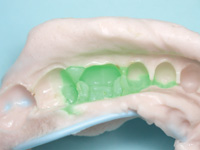
The agar-alginate laminate technique is an innovative method used in dentistry for impression-taking. This technique involves combining agar, a reversible hydrocolloid, with alginate, an irreversible hydrocolloid, to leverage the unique properties of each material.
Here’s how the agar-alginate laminate technique works:
- Preparation of Agar and Alginate Solutions:
- Agar solution: Agar is initially prepared in its gel state and stored in tubs or tubes.
- Alginate solution: Alginate powder is mixed with water to form a sol, typically at a ratio of 1:2. The alginate sol is then syringed onto the oral structures to be recorded.
- Application of Agar and Alginate:
- Agar sol application: The agar sol is syringed onto the desired oral structures, providing a stable base for the impression.
- Alginate sol application: Over the agar sol, a tray loaded with alginate sol is placed. Alginate, being irreversible, sets quickly to form a gel due to its chemical reaction upon contact with water.
- Gelation Process:
- The cool temperature of the alginate sol facilitates gelation of the agar sol beneath it. The agar sol undergoes a thermal process to convert from sol to gel, enhancing its stability and providing support to the impression.
- Impression Removal:
- Once the agar and alginate have fully set, the impression is carefully removed from the oral cavity. The agar base ensures structural integrity, while the alginate captures accurate details of the oral structures.
The agar-alginate laminate technique offers several advantages:
- The combination of agar and alginate optimizes the benefits of both materials, including stability, accuracy, and ease of use.
- Agar provides a solid base for the impression, preventing distortion during removal.
- Alginate captures fine details of the oral structures with precision, ensuring accurate reproduction in the final model or restoration.
